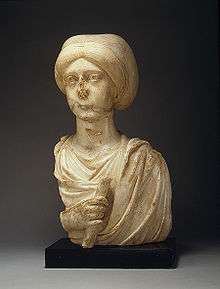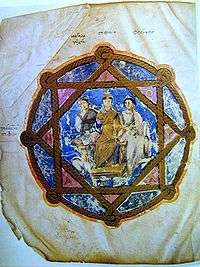Anicia Juliana


Anicia Juliana (Constantinople, 462 - 527/528) was a Roman imperial princess, the daughter of the Western Roman Emperor Olybrius, of the Anicii, by Placidia the younger daughter of Emperor Valentinian III and Licinia Eudoxia.
She married Flavius Areobindus Dagalaiphus Areobindus, and their children included Olybrius, consul for 491. With her husband, she spent her life at the pre-Justinian court of Constantinople, of which she was considered "both the most aristocratic and the wealthiest inhabitant".[1]
Her glittering genealogy aside, Juliana is primarily remembered as one of the first non-reigning female patrons of art in recorded history. From what little we know about her personal predilections, it appears that she "directly intervened in determining the content, as well, perhaps, as the style" of the works she commissioned.[2]
Her pro-Roman political views, as espoused in her letter to Pope Hormisdas (preserved in the royal library of the Escorial) are reflected in the chronicle of Marcellinus Comes, who has been associated with her literary circle. Whether Juliana entertained political ambitions of her own is uncertain, but it is known that her husband declined to take up the crown during the 512 riots. Although she resolutely opposed the Monophysite leanings of Emperor Anastasius, she permitted her son Olybrius to marry the Emperor's niece.[3]
Artistic influence
Juliana's name is attached to the Vienna Dioscurides, also known as the Anicia Juliana Codex, one of the earliest and most lavish illuminated manuscripts still in existence. The frontispiece features her depiction, the first donor portrait in the history of manuscript illumination, flanked by the personifications of Magnanimity and Prudence, with an allegory of the "Gratitude of the Arts" prostrate in front of her. The encircling inscription proclaims Juliana as a great patron of art.
Of her architectural projects, we know only three churches which she commissioned to be erected and embellished in Constantinople. The ornate basilica of St. Polyeuctus was built on her extensive family estates during the last three years of her life, with the goal of highlighting her illustrious pedigree which ran back to Theodosius I and Constantine the Great. Until Justinian's extension of the Hagia Sophia, it was the largest church in the imperial capital, and its construction was probably seen as a challenge to the reigning dynasty.[4] The dedicatory inscription compares Juliana to King Solomon and overtly alludes to Aelia Eudocia, Juliana's great-grandmother, who founded this church:
| “ | Eudocia the empress, eager to honor God, first built here a temple of Polyektos the servant of God. But she did not make it as great and beautiful as it is... because her prophetic soul told her that she would leave a family well knowing how to adorn it. Whence Juliana, the glory of her blessed parents, inheriting their royal blood in the fourth generation, did not disappoint the hopes of the empress, the mother of a noble race, but raised this from a small temple to its present size and beauty. (Greek Anthology, I.10) | ” |
References
- ↑ Maas, Michael. The Cambridge Companion to the Age of Justinian. Cambridge University Press, 2005. Page 439.
- ↑ Natalie Harris Bluestone, Double Vision: Perspectives on Gender and the Visual Arts (Fairleigh Dickinson University Press, 1995), p. 76 ISBN 0-8386-3540-7
- ↑ G.W. Bowersock, Oleg Grabar, Late Antiquity: A Guide to the Postclassical World (Harvard University Press, 1999), pp. 300-301
- ↑ The Cambridge Ancient History, 1925. Page 70.